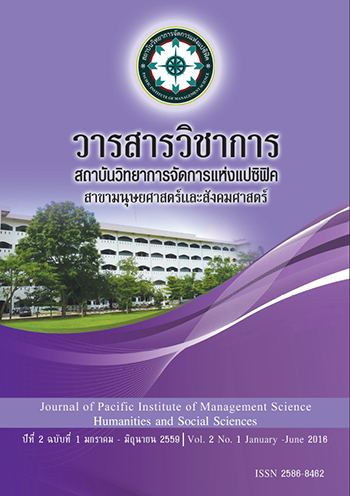Quality of Public Service Delivery of Municipality Typed Local Government in Leoi Province
Keywords:
quality, Public serviceAbstract
The objectives of this research are: (1) to study the levels of quality development of the public management, consisting of service recipients and stakeholders, measurement, analysis and knowledge management, human resource emphasis, and process management; (2) to study the levels of good governance principles, consisting of rule of law, virtue, transparency, participation, accountability, value for money; (3) to study the levels of public service delivery, consisting of equitable service, timely service, ample service, continuous service and progressive service; (4) to study factors concerning quality development of public management and good governance affecting service delivery quality of municipality-type local governments in Loei Province; and (5) to offer model of public management which will benefit public service delivery of municipality-type in Loei Province. The population of this study are 1998 municipal officers. Out of these, and according Krejcie and Morgan, 322 sever as sample to send the questionnaires to with the help of 5 chamber of Commerce members who serve as interviewees. The test of hypotheses is carried out by Multiple Regression Analysis – MRA.
It was found from the study that most of the respondents are females, 25-35 year of age, graduated with a bachelors degree, with a monthly income of 20,001-25,000 baht, Overall, the level of factors on service development of public management delivering services through municipality-type is at the highest level (X=4.31). Individually, giving importance to service recipients and stakeholders is at the highest level (X=4.52) while the lowest level is strategic planning (X=3.93). As to the overall opinion on good governance principles affecting service delivery, it is at the highest level (X=4.22).Individually, virtue is at the highest level (X=4.32) while accountability is at the lowest (X=4.04). With regard to the overall quality of service delivery, it is at the highest level (X=4.22). Individually, continuous service delivery is at the highest level (X=3.44) while ample service is at the lowest (X=3.22). It is found from the analysis of the Multiple Regression Analysis that leading, strategic planning, giving importance to service recipients and stakeholders, measurement, analysis and knowledge management emphasis on human resources, management process, rule of law, virtue, transparency. Participation and value for money are the predictors of the quality of service. Overall, it was found that leading, strategic planning giving importance to service recipients and stakeholders, measurement, analysis, knowledge management, emphasis on human resources, management process, rule of law, virtue, transparency, participation, accountability and value for money, all contribute to quality of service at 0.05 significant level.
References
ติน ปรัชญพฤทธิ์ (2543). ทฤษฎีองค์การ. พิมพ์ครั้งที่ 4 กรุงเทพฯ :ไทยวัฒนาพานิช.
ทิพาวดี เมฆสวรรค์ (2541). แนวคิดและหลักการทำงาน. กรุงเทพฯ : สถาบันที่ปรึกษาเพื่อพัฒนาประสิทธิภาพในราชการ.
ถวิลวดี บุรีกุล และวันชัย วัฒนศัพท์. (2549). โครงการขยายผลเพื่อนำตัวชี้วัดการบริหารกิจการบ้านเมืองที่ดีระดับ องค์กรไปสู่การปฏิบัติ นนทบุรี : สถาบันพระปกเกล้า.
บวรศักดิ์ อุวรรณโน. (2542). การสร้างธรรมาภิบาล (Good Governance) ในสังคมไทย. กรุงเทพฯ : วิญญูชน.
ลิขิต ธีรเวคิน. (2548). วิวัฒนาการการเมืองการปกครองของไทย. กรุงเทพฯ : มหาวิทยาลัยธรรมศาสตร์ .
สำนักงานคณะกรรมการข้าราชการพลเรือน. (2542). การปฏริปูระบบราชการ: การพัฒนาทรัพยากรมนุษย์เพื่อการปฏริปูระบบราชการ. กรุงเทพมหานคร. โรงพิมพ์สำนักงานคณะกรรมการข้าราชการพลเรือน.
สำนักงานคณะกรรมการพัฒนาระบบราชการ. (2551). คู่มือเทคนิคการปรับปรุงแลพัฒนาองค์การ. บริษัทวิชั่นพริ้นท์ แอนด์ มีเดีย จำกัด.
สถาบันพระปกเกล้า. (2545: 42). รายงานฉบับสมบูรณ์โครงการศึกษาเพื่อพัฒนาดชั้นวีดัผลการพัฒนาระบบการบริหาร จัดการที่ดี. โดยการสนับสนุนจากสำนักงานคณะกรรมการพัฒนาการเศรษฐกิจและสังคมแห่งชาติ.
สาคร สุขศรีวงศ์ . (2550). การจัดการ: จากมุมมองนกับริหาร (พิมพ์ครั้งที่ 3). กรุงเทพฯ : จี.พี. ไซเบอร์พรินท์
อัมมาร สยามวาลา. (2547). ศัพท์แสงว่าด้วยคอร์รัปชัน. เอกสารเผยแพร่ในการประชุมติดตาม นโยบายรัฐบาล “4 ปี ประเทศไทย ” เนื่องในวันต่อต้านคอร์รัปชันแห่งสหประชาชาติ. 9 ธันวาคม 2547 ณ โรงแรมวินเซอร์สวีท กรุงเทพมหานคร.
Anthony J Dunne. (2006). Organizational Leaning in a food Industry Value Chain. Queensland : University of Southern Queensland.
Catt, H. (1999). Democracy in Practice. London and New York: Rutledge.
Dubnick, M. (1981). The American political science review, Volume 75, ssuc 2 June., 500 -201.
Good, C. V. (1973). Dictionary of Education. New York: McGraw – Hill.
Green, D.J. (1994). Foams Ceramic. The Encyclopedia of Advance Material, 2, 871-874.
Hilliard G V., & Norman D K. (1999). Department of Public Management and Business Management. Port.
Mc Closky, H. (1968). Political Participation. International Encyclopedia of the social sciences, Vol. 12 New York: McMillan and Free Press.
Price, A. (2004). Human resource management. In a Business Context (2nd edition). London: Thomson Learning.
Romzek, B., & Meivin J.D.k. (1987). “Accountability in the Publication Encyclopedia: Lessons Form The Challenger Tragedy”. Public Administration Review. May/June.
Verba, S. N. N. H., & Kim J. O. (1978). Participation and Political Equality. New York: Cambridge University.
Downloads
Published
Issue
Section
License
บทความที่ได้รับการตีพิมพ์เป็นลิขสิทธิ์ของ สถาบันวิทยาการจัดการแห่งแปซิฟิค
ข้อความที่ปรากฏในบทความแต่ละเรื่องในวารสารวิชาการเล่มนี้เป็นความคิดเห็นส่วนตัวของผู้เขียนแต่ละท่านไม่เกี่ยวข้องกับสถาบันวิทยาการจัดการแห่งแปซิฟิค และคณาจารย์ท่านอื่นๆในสถาบันฯ แต่อย่างใด ความรับผิดชอบองค์ประกอบทั้งหมดของบทความแต่ละเรื่องเป็นของผู้เขียนแต่ละท่าน หากมีความผิดพลาดใดๆ ผู้เขียนแต่ละท่านจะรับผิดชอบบทความของตนเองแต่ผู้เดียว







